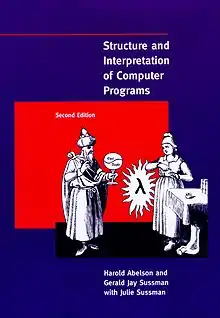Structure and Interpretation of Computer Programs
Structure and Interpretation of Computer Programs (SICP) is a computer science textbook by Massachusetts Institute of Technology professors Harold Abelson and Gerald Jay Sussman with Julie Sussman. It is known as the "Wizard Book" in hacker culture.[1][2] It teaches fundamental principles of computer programming, including recursion, abstraction, modularity, and programming language design and implementation.
 Cover of the second edition | |
| Author | Harold Abelson, Gerald Jay Sussman, Julie Sussman |
|---|---|
| Subject | Computer science |
| Genre | Textbook |
| Publisher | MIT Press |
Publication date | 1984 (1st ed.), 1996 (2nd ed.), 2022 (JavaScript ed.) |
| Pages | 657 |
| ISBN | 0-262-51087-1 (2nd ed.) |
| LC Class | QA76.6 .A255 1996 |
| Website | mitpress |
MIT Press published the first edition in 1984, and the second edition in 1996. It was formerly used as the textbook for MIT's introductory course in computer science. SICP focuses on discovering general patterns for solving specific problems, and building software systems that make use of those patterns.[3]
MIT Press published the JavaScript edition in 2022.[4]
Content
The book describes computer science concepts using Scheme, a dialect of Lisp. It also uses a virtual register machine and assembler to implement Lisp interpreters and compilers.
Topics in the books are:
Chapter 1: Building Abstractions with Procedures
- The Elements of Programming
- Procedures and the Processes They Generate
- Formulating Abstractions with Higher-Order Procedures
Chapter 2: Building Abstractions with Data
- Introduction to Data Abstraction
- Hierarchical Data and the Closure Property
- Symbolic Data
- Multiple Representations for Abstract Data
- Systems with Generic Operations
Chapter 3: Modularity, Objects, and State
- Assignment and Local State
- The Environment Model of Evaluation
- Modeling with Mutable Data
- Concurrency: Time Is of the Essence
- Streams
Chapter 4: Metalinguistic Abstraction
- The Metacircular Evaluator
- Variations on a Scheme – Lazy Evaluation
- Variations on a Scheme – Nondeterministic Computing
- Logic Programming
Chapter 5: Computing with Register Machines
- Designing Register Machines
- A Register-Machine Simulator
- Storage Allocation and Garbage Collection
- The Explicit-Control Evaluator
- Compilation
Characters
Several fictional characters appear in the book:
- Alyssa P. Hacker, a Lisp hacker
- Ben Bitdiddle
- Cy D. Fect, a "reformed C programmer"
- Eva Lu Ator
- Lem E. Tweakit
- Louis Reasoner, a loose reasoner
License
The book is licensed under a Creative Commons Attribution-ShareAlike 4.0 International (CC BY-SA 4.0) license.[5]
Coursework
The book was used as the textbook for MIT's former introductory programming course, 6.001,[6] from fall 1984 through its last semester, in fall 2007.[7] Other schools also made use of the book as a course textbook.[8] Various versions of the JavaScript edition have been used by the National University of Singapore since 2012 in the course CS1101S.[9]
Reception
Byte recommended SICP in 1986 "for professional programmers who are really interested in their profession". The magazine said that the book was not easy to read, but that it would expose experienced programmers to both old and new topics.[10]
Influence
SICP has been influential in computer science education, and several later books have been inspired by its style.
- Structure and Interpretation of Classical Mechanics (SICM), another book that uses Scheme as an instructional element, by Gerald Jay Sussman and Jack Wisdom
- Software Design for Flexibility, by Chris Hanson and Gerald Jay Sussman
- How to Design Programs (HtDP), which intends to be a more accessible book for introductory Computer Science, and to address perceived incongruities in SICP
- Essentials of Programming Languages (EoPL), a book for Programming Languages courses
See also
- Structure and Interpretation of Computer Programs, JavaScript Edition
- Compilers: Principles, Techniques, and Tools – also known as The Dragon Book
References
- Raymond, Eric S.; Steele, Guy (1991). The New hacker's dictionary. Internet Archive. Cambridge, Mass. : MIT Press. ISBN 978-0-262-68069-1.
- "The Top 9 1/2 Books in a Hacker's Bookshelf", Grok code, retrieved 2010-10-23
- Harvey, B (2011), "Why SICP matters?", The 150th anniversary of MIT, Boston Globe.
- Structure and Interpretation of Computer Programs: JavaScript Edition, MIT Press, 2022
- "SICP". MIT Press. Archived from the original on 2017-12-26. Retrieved 2007-11-11..
- "Electrical Engineering and Computer Science; 6.001 Structure and Interpretation of Computer Programs". OpenCourseWare. MIT. Spring 2005. Retrieved 2020-06-21.
- Guy, Donald, "The End of an Era", MIT Admissions (blog comment), archived from the original on 2018-08-21, retrieved 2008-08-05,
I talked to Professor Sussman on the phone... He said that he'd actually been trying to have 6.001 replaced for the last ten years (and I read somewhere that Professor Abelson was behind the move too). Understanding the principles is not essential for an introduction to the subject matter anymore. He sees 6.001 as obsolete.
- "Universities and Colleges Using SICP". MIT Press. Archived from the original on 2022-04-23. Retrieved 2022-03-30.
- "Department of Computer Science; CS1101S Programming Methodology". NUS. Fall 2021. Retrieved 2020-07-17.
- Kilov, Haim (November 1986). Byte Magazine Volume 11 Number 12: Knowledge Representation. p. 70.